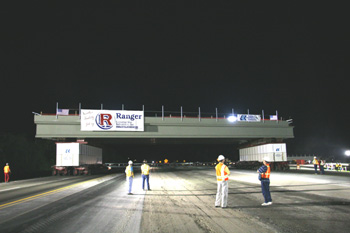Benefits
SPMT technology delivers many benefits. Several are highlighted here:
Significantly Reduce Traffic Disruption

SPMTs allow workers to remove or place whole bridge structures on busy roadways in just minutes or a few hours. Most of the complex – and often hazardous – work of building or removing structures in the path of existing traffic occurs offsite. Roadway interruptions occur only in the very brief windows of time in which a structure is being positioned for installation or carried offsite for demolition.
Open Highways to Traffic in Hours
During conventional bridge construction, traffic that travels under the bridge is typically restricted during certain types of activity to protect motorist and worker safety. SPMTs can greatly reduce the duration of such interruptions. Delays typically can last days when demolishing, building, or repairing bridges. With SPMT, traffic can return to normal within hours thanks to the innovative practice of building the structure off-site, then placing it quickly with the SPMT.

Improve Work Zone Safety
SPMT technology allows the prefabrication of structures in offsite staging areas, where construction crews can perform most of their work away from traffic. This improves the safety of the work environment and reduces the exposure of motorists to roadway work zone hazards. Significant worker safety benefits are also derived from the ability to work during the day without interruptions and near ground level throughout the construction process.

Improve Quality and Constructability
Since SPMTs allow bridges to be built in the controlled environment of an off-road site, the focus remains solely on construction rather than the need to accommodate traffic. In this environment the more uniform production capability with adequate time for proper concrete curing leads to consistent overall quality and constructability of the finished product.

Increase Contractor and Owner Options
SPMT technology fuels flexibility in choosing staging areas. Lifting the structure from below and “driving” it into (or out of) place eliminates many issues related to overhead height restrictions that impact crane lifting operations, while the supported SPMT loads provide added safety assurance relative to suspended crane loads.
Offsite staging allows the contractor to work in daylight and extend work hours as needed in a safer environment. For example, onsite foundation and substructure work can occur simultaneously with superstructure fabrication, saving significant construction time. The benefits of offsite construction speed can be further increased by driving in multi-span bridges complete with substructures.
SPMTs can also be used to relocate existing spans onto new foundations to accommodate mainline widening or new interchange configurations.
Finally, “mom and pop” construction companies can use this technology as readily as larger companies because SPMT vendors provide hands-on engineering services that assist contractors with specialty issues.
Best Applications
The cost of mobilizing SPMT technology is offset by significant project savings that may include:
-
fewer and shorter maintenance-of-traffic setups
-
shorter hours for law enforcement officers due to fewer rolling roadblocks
-
time savings from fewer shift changes for construction crews
-
the elimination of temporary detour construction and repair of long-term detours on existing roads
-
the use of smaller owner and contractor crews
-
reduced onsite time required for owner agency engineering and inspection requirements due to accelerated construction
-
a vast reduction in the myriad user costs associated with construction-related delay, detour, and congestion
-
less maintenance and repair costs associated with better long-term performance of the prefabricated structure
Contractors realize particular savings due to the significantly reduced onsite construction time. These may include:
-
lower insurance premiums
-
lower labor costs (for water work)
-
increased volume of projects due to the speed of construction and installation
-
reduced manpower costs
-
reduced equipment rental time
